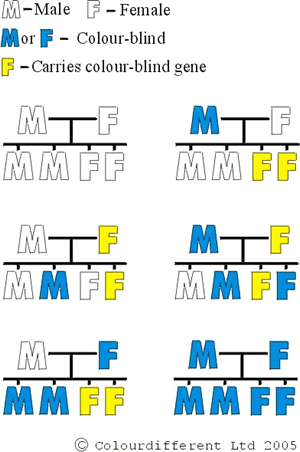About Colour-Blindness
 Colour blindness is a condition in which certain colours cannot be distinguished correctly and is always inherited.
Colour blindness is a condition in which certain colours cannot be distinguished correctly and is always inherited.
Red/Green colour blindness is by far the most common and causes problems in distinguishing these colours. This characteristic is nearly always confined to men and occurs in about 5% - 8% of males of European origin and only about 0.5% of the female population, as they are the carriers of the defective gene.
Colour blindness is a malfunction of the retina, which converts light energy into electrical energy that is then transmitted to the brain.
The cones are responsible for perceiving colour and they do this by having receptors that are sensitive to each of three wavelengths of light - red, green, and blue. People with normal vision are able to match all the colours of the spectrum by means of these three colours.
Defects in colour vision occur when one of the three receptors does not function correctly. In the case of mild colour-blindness the receptor functions, but not well, and in the case of severe colour-blindness it does not function at all.
Deficiencies in the blue receptor are extremely rare, as is total loss of colour vision.
Partial or total loss in these two receptors therefore give us the four main types of colour vision defect.
Partial loss in red receptor - Protanomaly (1% of the male population)
Red weak - Suffers from a dimming in the intensity and brightness of the colour red.
Partial loss in green receptor - Deuteranomaly (5% of the male population)
Green weak.- Poor at discriminating small differences in hues in the red, orange, yellow, green region of the spectrum.
Total loss of the red receptor - Protanopia (1% of the male population)
Red, orange, yellow and green appear the same colour with the brightness and intensity at the red end of the spectrum severely reduced.
Total loss of the green receptor - Deuteranopia (1% of the male population)
Red, orange, yellow and green appear the same colour.
As you can see it can be a difficult to get colours right for each of the main colour-blind types, but when you consider that there are up to 2 million colour-blind people in the UK, 13 million in North America, 29 million in Europe and probably over 320 million world-wide, it is certainly worth the effort.
Please contact us for more information.


